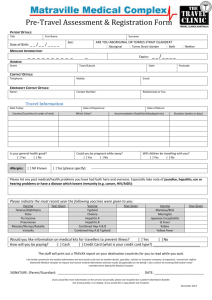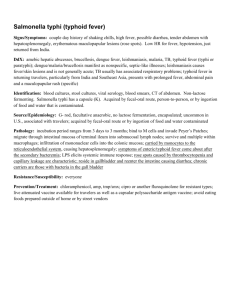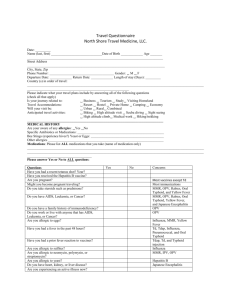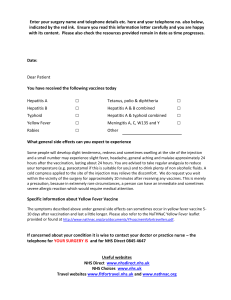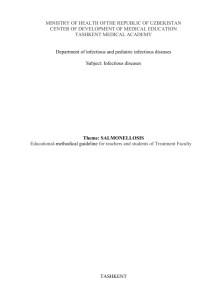Approved
advertisement
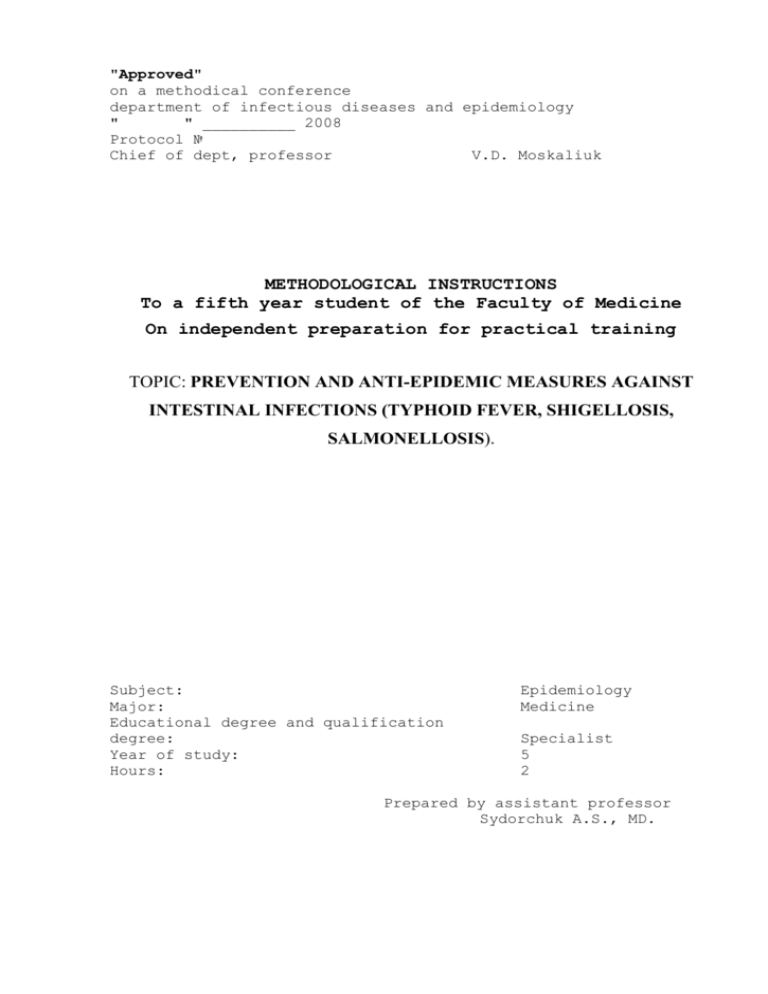
"Approved" on a methodical conference department of infectious diseases and epidemiology " " __________ 2008 Protocol № Сhief of dept, professor V.D. Moskaliuk METHODOLOGICAL INSTRUCTIONS To a fifth year student of the Faculty of Medicine On independent preparation for practical training TOPIC: PREVENTION AND ANTI-EPIDEMIC MEASURES AGAINST INTESTINAL INFECTIONS (TYPHOID FEVER, SHIGELLOSIS, SALMONELLOSIS). Subject: Major: Educational degree and qualification degree: Year of study: Hours: Epidemiology Medicine Specialist 5 2 Prepared by assistant professor Sydorchuk A.S., MD. 1. Topic: Prevention and Anti-epidemic Measures against Intestinal Infections. 2. Lesson duration: 2 hours 3. Aims of study: 3.1. Students must know: - aetiology of typhoid fever, shigellosis, salmonellosis; - social conditions that promote occurence and spreading of intestinal infections; - mechanisms and transmission ways of infection stimulus in case typhoid fever, shigellosis, salmonellosis; - sequence of epidemiologic inspection of the nidus; - actions to eliminate epidemic nidus of typhoid fever, shigellosis, salmonellosis according to the scheme: isolation forms (hospitalization) of a patient, subsequent care of people who already had the illnesses, disinfection methods and disinfectants, preventive measures for healthy people (observation). - rules of discharge of reconvalescents. 3.2. Students must be able to: - draw up an epidemiological analysis; - develop indications to conduct epidemiological inspection of the nidus; - make a plan of anti-epidemic measures to destroy nidi of intestinal infections; - fill in medical documents of an epidemic inspection of nidus (emergency information report, epidemiologic inspection card, control card of patient under clinic observation); 3.3.Students must master the following practical skills: - how to draw up an epidemiological anamnesis and analysis of the information received; - how to fill in document forms; - how to do an inspection of the epidemiological nidus of intestinal infections; - how to make a plan of counteractions on the base of epidemiological inspections of the nidus. 4. Students are advised to: - pay special attention to specific features of epidemiological inspection of nidi of infectious illnesses of infections. - pay attention to functional duties of epidemiologist who received informationon occurrence of intestinal infection nidus; - when drawing up an epidemiological anamnesis, take into consideration duration of incubation period (minimum and maximum). - pay attention to factors of transmission of typhoid fever, shigellosis, salmonellosis. Advances in the prevention and treatment of typhoid fever. Control of Salmonella, typhi infection transmitted from person to person depends on high standards of personal hygiene, maintenance of a supply of uncontaminated water, proper sewage dispose and identification, treatment, and follow-up of chronic carriers. Hand washing is of paramount importance in controlling person – to person spread although hands of convalescent carriers are often contaminated after defecation detectable Salmonella are easily removed by washing the hands with soap and water. Typhoid fever vaccine, a saline suspension of aceton or heat/phenol killed S.typhi enhances the resistance of human beings to infection with S.typhi under experimental and natural conditions. Vaccine efficacy ranges from 51 to 67 %. There is also renewed interest in testing the capsular polysaccharide of S.typhi (Vi antigen) as a parenteral typhoid fever vaccine. Typhoid fever vaccine should be considered for persons with intimate continuing exposure to a documented typhoid fever carrier and for persons traveling to areas where there is a recognized appreciable risk to exposure to typhoid fever. In spite of the achieved success in the pseudotuberculosis study, the problems of the specific prophylaxis have not been worked out so far. A complex of nonspecific measures directed at the source and transmission factors is widely used in the medicine to prevent the pseudotuberculosis spreading. MEASURES AGAINST SHIGELLOSIS Prophylaxis of shigellosis includes complex of measures, directed to revelate the source of the infection, interrupt the ways of the transmission, increase of the organism resistance. Keeping the rules of personal hygiene and rules of food’s cooking plays the principal role in prophylaxis of the disease. Sanitary education of population has an important meaning in shigellosis prophylaxis too. Prophylaxis of the toxical food infection is concluded in prevention of infection of the food-stuff, of the reproduction of the microorganisms in the food. It is necessary to keep the food-stuffs and prepared food at the temperature from 2 till 4 ºC. The mechanization and automatization of the food objects, the elaboration of the new methods of the preserving and storage of the foodstuff, the freezing at low temperature are conductive to the successful prophylaxis of the toxical food infection. MEASURES AGAINST SALMONELLOSIS The measures of prophylaxis are veterinary-surveillance upon animals and production of meat and dairy industry, laboratory control of food stuffs. It is necessary to reveal carriers on milk farms, in foods, children’s and medical establishments. The maintenance of the rules of personal hygiene and rules of food’s cooking plays an important role in prophylaxis of Salmonellosis. The observance of the sanitary and hygienic rules at processing, transportion, keeping and preparing of the food-stuffs experts possibility of accumulation of botulotoxin. It is necessary to perform the strict control under sterilization and keeping preserved food-stuffs. The explanation to the people of the rules of the procurement and preservation of food-stuffs in home conditions has important meaning especially such food-stuffs as meat, mushrooms, vegetables. The measures of prophylaxis of Cholera depend on epidemic situation in the country. The information of world health organisation about cases of cholera in different countries has an important meaning. The incidence of disease can be diminished by sanitary-hygienic measures, sanitary disposal of human feces, purification and protection of water supplies, pasteurization of milk and milk products, strict sanitary supervision of preparation and serring of flood exclusion of persons with diarrhea from handling food, organization of the work about diseases of gastrointestinal tract and their examination on cholera. Specific prophylaxis of cholera is performed by corpuscular vaccine and cholerogen-anatoxin. Parenterally inoculated killed complete cell vaccine has been available for years, this vaccine stimulates high titers of serum vibriocidal antibodies, but it does not induce antibodies to toxin. Protection by vaccine has been induced for approximately 1 years, with vaccine efficacy approximately 70%. Local gastrointestinal tract immunity against the organism and against the toxin should provide a better, less reactogenic immunogen using recombinant DNA technology an ”attenuated” V. Cholerae organism that lacks the genes for production of the A and B subunits of toxin was created. A plasmid containing the subunit gene was then constructed and inserted. Thus a candidate live V.cholera vaccine containing all the cell-was antigens necessary for adherence and the capacity to produce only the subunit of toxin has been engineered. 5. Test questions 1. What is an epidemic nidus? 2. What does extent of the nidus depend on? 3. What are the sites a specialist must visit when carrying out epidemiological inspections? 4. How long does it take? 5. List of documents required registering results of epidemiological inspection, and their significance. 6. List measures necessary to be taken to eliminate epidemic nidi, and their sequence. 7. When a nidus of a respiratory tract infection can be regarded eliminated? 8. Name the mechanism and ways of transmission of typhoid fever, shigellosis, salmonellosis. 9. What is the epidemiological theory of correspondence? Its significance for applied epidemiology. 6. References. A. Basic: Epidemiology and Fundamentals of Infectious Diseases. M.L. Volovskaya. Mir Publisher. Moscow. B. Adding: A Lange Medical book. Medical Epidemiology. Second Edition. Raymond S.Greenberg, Stephen R.Daniels. – Aplleton, Stamford, Connecticut. – 1996. – P.195.


